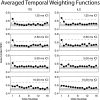Temporal weighting of interaural time and level differences in high-rate click trains
- PMID: 20649228
- PMCID: PMC2921433
- DOI: 10.1121/1.3436540
Temporal weighting of interaural time and level differences in high-rate click trains
Abstract
Temporal weighting functions (TWFs), quantifying sensitivity to interaural time differences (ITD) and interaural level differences (ILD) over the duration of brief stimuli, were measured in 6 normal hearing subjects using trains of 16 Gabor clicks centered at 4 kHz presented dichotically at 4 rates [inter-click intervals (ICI) of 10, 5, 2.5, and 1.25 ms]. Random ITD or ILD were imposed independently on each click in the train in separate conditions. The subject's task was to discriminate the lateral position of the click train ("left" or "right"). Receiver operating characteristic (ROC) analysis was then used to quantify the effectiveness or "weight" of each click according to individual click ITD or ILD. Although individual differences were evident, onset cues appeared to dominate at high rates. Onset dominance was apparent for both ITD and ILD at 1.25 ms ICI and for ITD at 2.5 ms ICI, but for neither cue at 5 or 10 ms ICI. Onset dominance was greater on average for ITD than ILD, although TWFs were qualitatively similar for the two cues. No evidence was found for "upweighting" of late-arriving ILD [Stecker, G. C., and Hafter, E. R. (2009), J. Acoust. Soc. Am. 125, 3914-3924].
Figures





Similar articles
-
Temporal weighting functions for interaural time and level differences. III. Temporal weighting for lateral position judgments.J Acoust Soc Am. 2013 Aug;134(2):1242-52. doi: 10.1121/1.4812857. J Acoust Soc Am. 2013. PMID: 23927122 Free PMC article.
-
Temporal weighting functions for interaural time and level differences. II. The effect of binaurally synchronous temporal jitter.J Acoust Soc Am. 2011 Jan;129(1):293-300. doi: 10.1121/1.3514422. J Acoust Soc Am. 2011. PMID: 21303010 Free PMC article.
-
Temporal weighting functions for interaural time and level differences. IV. Effects of carrier frequency.J Acoust Soc Am. 2014 Dec;136(6):3221. doi: 10.1121/1.4900827. J Acoust Soc Am. 2014. PMID: 25480069 Free PMC article.
-
Temporal weighting of binaural cues revealed by detection of dynamic interaural differences in high-rate Gabor click trains.J Acoust Soc Am. 2010 May;127(5):3092-103. doi: 10.1121/1.3377088. J Acoust Soc Am. 2010. PMID: 21117758 Free PMC article.
-
[Sound localization cues of binaural hearing].Laryngorhinootologie. 2003 Apr;82(4):240-8. doi: 10.1055/s-2003-38932. Laryngorhinootologie. 2003. PMID: 12717598 Review. German.
Cited by
-
Sub-optimal construction of an auditory profile from temporally distributed spectral information.J Acoust Soc Am. 2021 Mar;149(3):1567. doi: 10.1121/10.0003646. J Acoust Soc Am. 2021. PMID: 33765831 Free PMC article.
-
Temporal weighting functions for interaural time and level differences. V. Modulated noise carriers.J Acoust Soc Am. 2018 Feb;143(2):686. doi: 10.1121/1.5022785. J Acoust Soc Am. 2018. PMID: 29495689 Free PMC article.
-
Threshold of the precedence effect in noise.J Acoust Soc Am. 2014 May;135(5):2923-30. doi: 10.1121/1.4869682. J Acoust Soc Am. 2014. PMID: 24815272 Free PMC article.
-
Binaural interference with simulated electric acoustic stimulation.J Acoust Soc Am. 2019 Apr;145(4):2445. doi: 10.1121/1.5098784. J Acoust Soc Am. 2019. PMID: 31046315 Free PMC article.
-
Effects of interaural decoherence on sensitivity to interaural level differences across frequency.J Acoust Soc Am. 2021 Jun;149(6):4630. doi: 10.1121/10.0005123. J Acoust Soc Am. 2021. PMID: 34241434 Free PMC article.
References
-
- Blauert, J. (1997). Spatial Hearing: The Psychophysics of Human Sound Localization, revised ed. (MIT, Cambridge, MA: ).
Publication types
MeSH terms
Grants and funding
LinkOut - more resources
Full Text Sources

